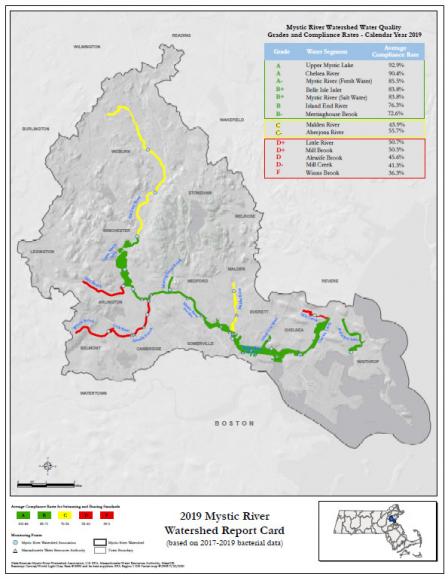News Releases from Region 01
Annual Report Card Indicates Improving Bacterial Water Quality in the Mystic River in 2019
BOSTON – The Mystic River Watershed Association, in collaboration with the U.S. Environmental Protection Agency (EPA), announced its annual Water Quality Report Card on the Mystic River watershed for 2019. For the sixth year in a row, water quality monitoring data show that water quality for bacterial levels in the main stem of the Mystic River, including the Upper and Lower Mystic Lakes, is very good on a regular basis and meets water quality standards for bacteria nearly all the time, especially in dry weather.
"We are incredibly fortunate to have such a clean urban river as part of the Boston Harbor watershed," said EPA Regional Administrator Dennis Deziel. "Improving water quality in the watershed is a focus for EPA. We continue to see natural resources such as the Mystic River serve as a driver for further environmental improvements and smart development in dense, urban areas."
"This milestone shows both the power of sustained attention to water quality in the Mystic Watershed, and the need for continued diligence," said Martin Suuberg, Commissioner of the Massachusetts Department of Environmental Protection (MassDEP). "We look forward to continued work with federal, state, local, community and advocacy partners moving forward."
"EPA provides a great public service by partnering in this annual report card on this most urbanized river system in Massachusetts," said Executive Director of the Mystic River Watershed Association Patrick Herron. "The good news is the Mystic River itself is a remarkably clean urban river. The bad news is that other water bodies need work. This report card helps point the way forward for all stakeholders, state, federal and local."
The report card gives grades to 14 segments of the Mystic River Watershed, and it shows improvement in some segments of the watershed in 2019, which indicates that work to reduce bacterial contamination continues to show positive changes.
While no single "overall" grade is generated for the Mystic River watershed as a whole, the data show that the main stem of the river is routinely safe for swimming and boating; however, bacterial levels in several of the tributary streams feeding the Mystic are high, and these areas often do not meet water quality standards.
In 2019, some of these problem streams showed signs of improvement, especially the Island End River on the border of Everett and Chelsea, where infrastructure work was done to reduce sewage inputs into the stormwater system. In 2019, for the first time ever, the Island End River has received a grade of "B." The Island End River has steadily improved from an "F" in 2016 and earlier years. "The Island End River is a great example of real, quantifiable improvement in water quality that can be achieved when communities work together and solve environmental problems" said EPA New England Regional Administrator Deziel.
Background
The report card grades issued annually for the Mystic River are calculated by the MyRWA in collaboration with EPA. The grades are based on the level of bacterial contamination found in samples collected by MyRWA volunteers during the 2019 calendar year at 15 monitoring sites throughout the entire watershed, as well as data collected at numerous locations by the Massachusetts Water Resources Authority (MWRA). The grades are calculated using a three-year rolling average, allowing for a more complete and accurate assessment of recent water quality that addresses weather variability from year to year.
For the past several years, the EPA, in partnership with the MassDEP, has had an active enforcement program focused on finding sources of bacteria in the Mystic. Through innovative approaches to field testing and laboratory methods, EPA has been able to identify sources of illicit discharges and require communities to find and fix illegal connections. This work has prevented more than 43,000 gallons per day of sewage from entering the Mystic River watershed.
More work is scheduled for these tributaries. Many communities are actively investigating their discharges and are completing repairs to their sanitary and storm sewer systems, which will prevent tens of thousands of gallons of sewage from discharging to the river during rain events.
In addition to bacterial contamination, the Mystic River watershed also suffers from excess nutrients, primarily phosphorus, entering the river from stormwater. Starting in 2016, EPA, MassDEP, and MyRWA worked with watershed stakeholders and technical experts to develop a study of nutrient-related water quality impairments and necessary pollutant load reductions to achieve water quality goals in the Mystic River watershed.
The recently completed Mystic River Watershed Alternative TMDL Report identifies stormwater runoff as the primary source of phosphorus in the watershed and provides estimates of the phosphorus load reductions necessary to attain Massachusetts Surface Water Quality Standards and restore designated uses including swimming, boating, and fishing. The study is available at the following link: https://19january2021snapshot.epa.gov/mysticriver/environmental-challenges-mystic-river-watershed#NutrientChallenges.
This report card is part of the EPA's long-term effort to improve this vital waterway through support for the Mystic River Watershed Initiative Steering Committee. The Steering Committee includes EPA and MyRWA representatives, as well as representatives from other federal and state agencies, and numerous public advocacy groups and municipalities from throughout the area, and was formed to help foster a strategic, community-driven approach to water quality improvement.
More information on EPA's Mystic River Watershed Initiative: https://19january2021snapshot.epa.gov/mysticriver
Attachment: Map of Mystic River Watershed illustrating water quality conclusions for today's report card.
 View a larger version of this image [ JPEG | PDF(1 pg, 7 MB, About PDF) ].
View a larger version of this image [ JPEG | PDF(1 pg, 7 MB, About PDF) ].
